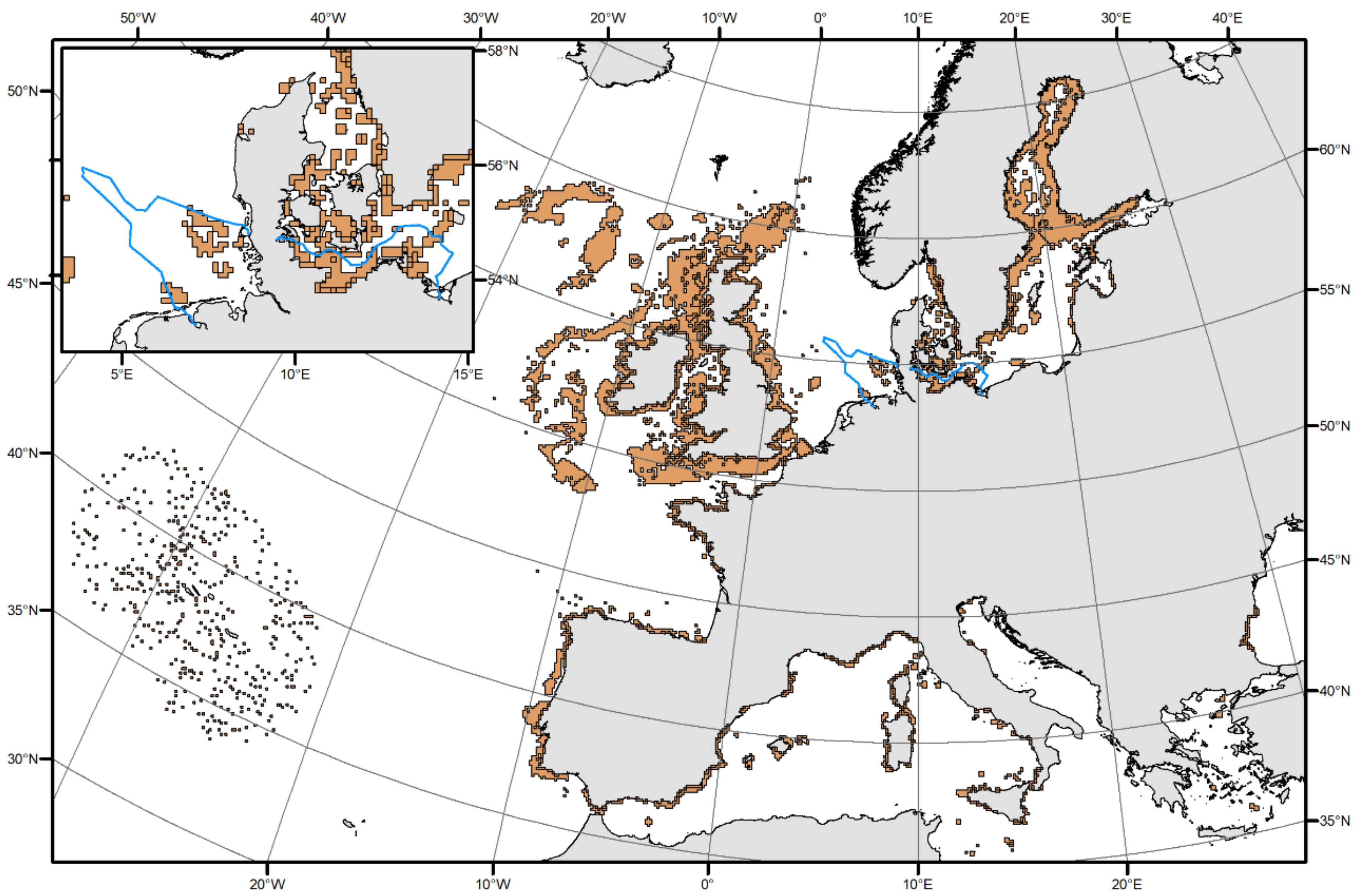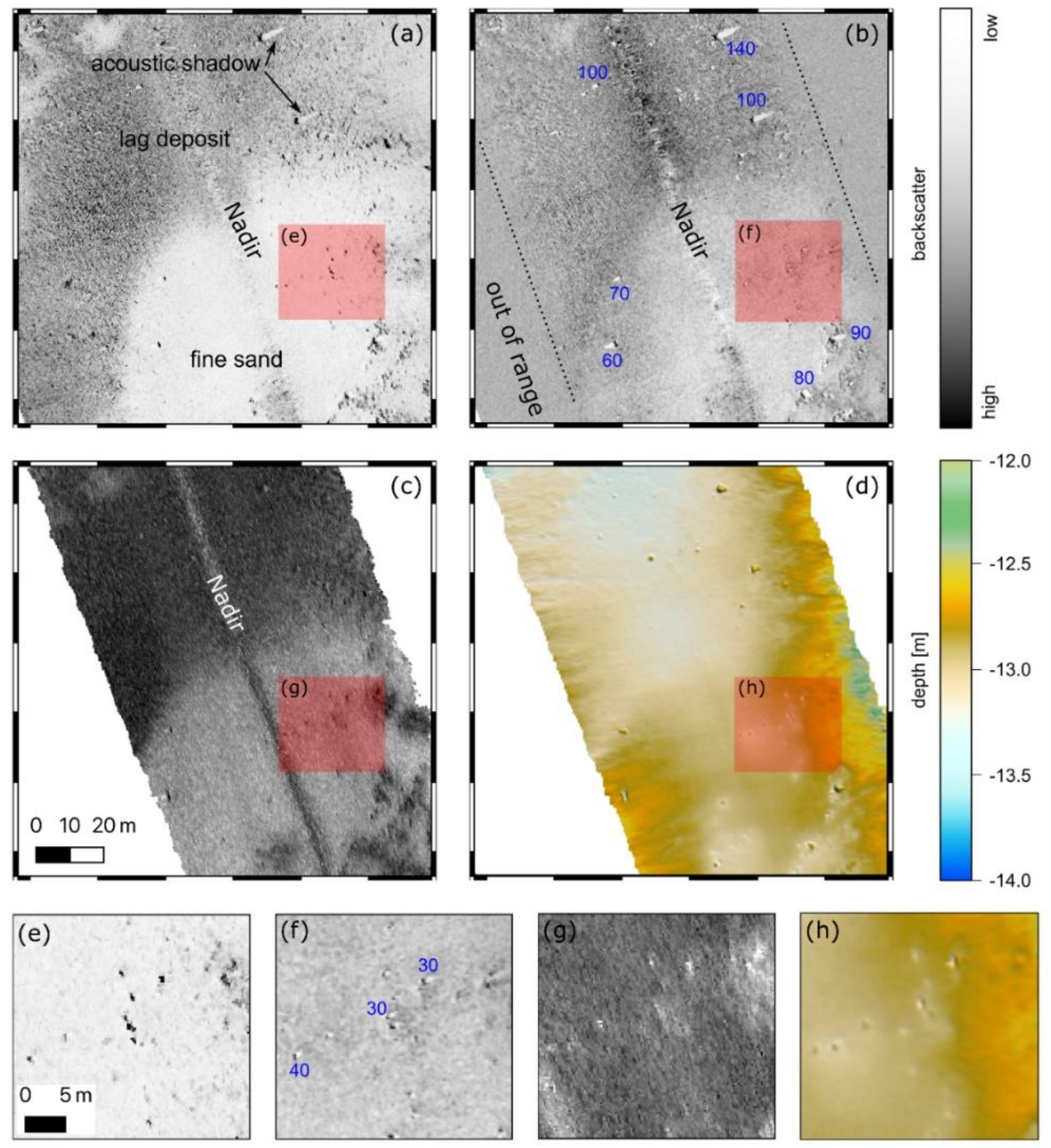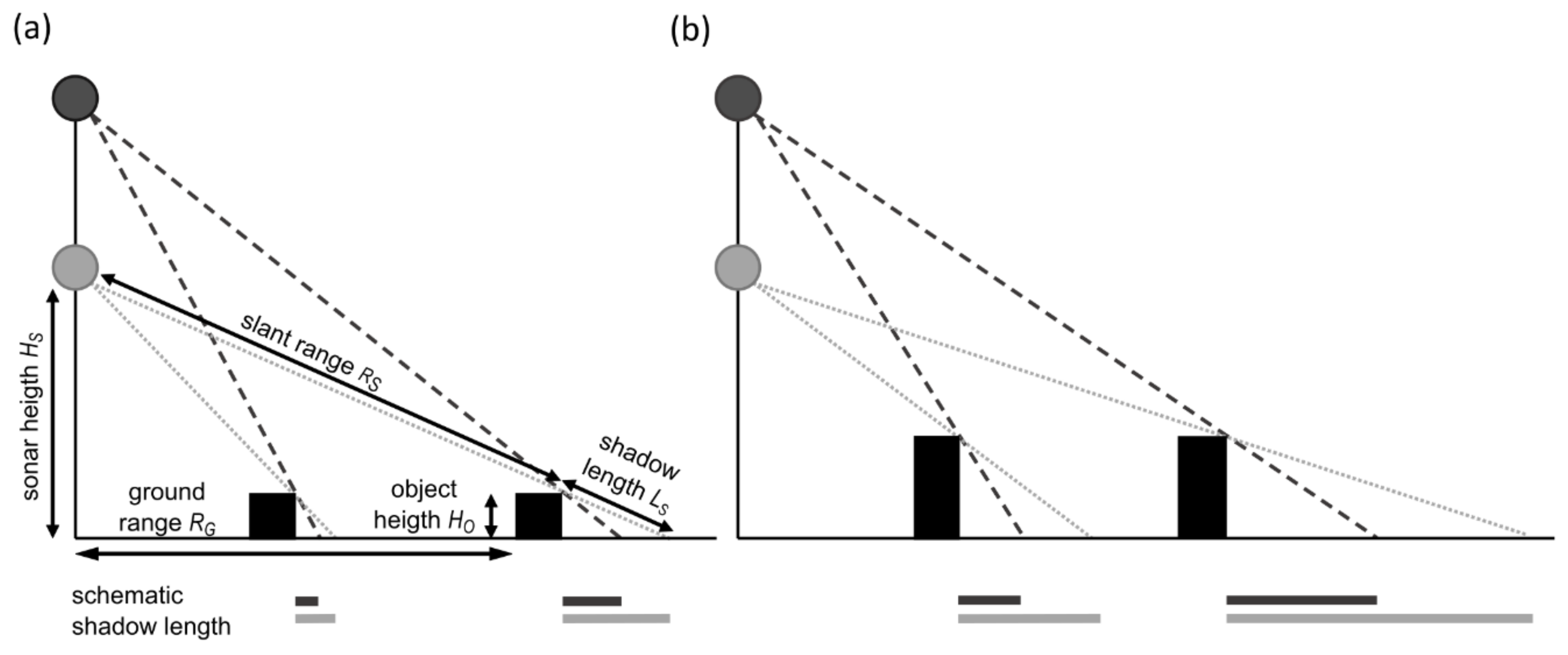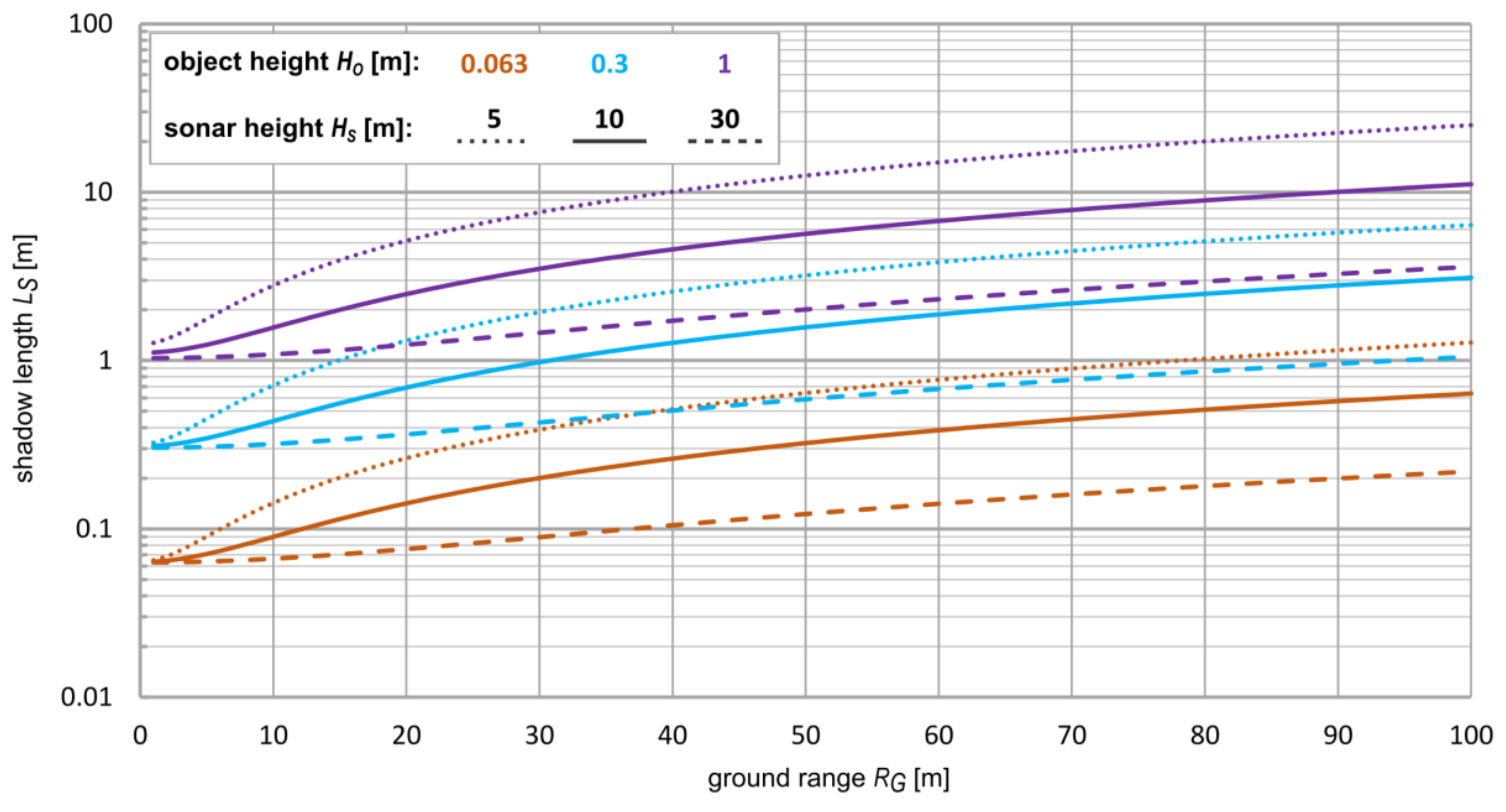Hydroacoustic Mapping of Geogenic Hard Substrates: Challenges and Review of German Approaches
Abstract
1. Introduction
- The “Council Directive 92/43/EEC on the Conservation of Natural Habitats and of Wild Fauna and Flora” known as the Habitats Directive (HD) assures the conservation of natural habitats and lists these in Annex 1 [16]. To clear any ambiguities in the interpretation of Annex 1 the Directorate General for Environment (DG ENV) developed the “Interpretation Manual of European Union Habitats” [17]. The HD forms (together with the Birds Directive) the foundation of the Natura 2000 ecological network of protected areas.
- The Marine Strategy Framework Directive (MSFD, 2008/56/EC) aims to achieve or maintain good environmental status of all marine ecosystems including benthic habitats under descriptor 1 (biodiversity) and descriptor 6 (seafloor integrity) across the European Union while enabling the sustainable use of marine goods and services [18].
2. Definitions and Delineation Criteria of Hard Substrates
- (1)
- Boulder field: This type typically occurs in areas characterized by a heterogeneous sediment distribution. Each hard substrate object of a certain size needs to be identified and surrounded by a bounding boundary of a certain diameter. The values differ for North Sea and Baltic Sea. For details see Table 2. The bounding boundaries of at least 21 objects are needed to be connected within a certain radius to form a reef. A biological verification is not required.
- (2)
- Marine erratic boulders: Each erratic boulder (≥2 m in diameter) is defined as reef disregarding their areal distribution density. A biological verification is not necessary.
- (3)
- Lag deposits with erratic cobbles and boulders: Lag deposits typically contain a wide range of hard substrate sizes mixed with sand and gravel. Single object detection is not required. The entire area is classified as reef when characteristic reef species assemblages are present.
3. Hard Substrate Origin
4. History of Geogenic Hard Substrate Investigation Activities
5. Hydroacoustic Mapping Techniques
6. Automated Stone Detection
7. Conclusions and Future Needs
Author Contributions
Funding
Acknowledgments
Conflicts of Interest
References
- Sheehan, E.V.; Bridger, D.; Attrill, M.J. The ecosystem service value of living versus dead biogenic reef. Estuar. Coast. Shelf Sci. 2015, 154, 248–254. [Google Scholar] [CrossRef]
- Taylor, R. Density, biomass and productivity of animals in four subtidal rocky reef habitats: The importance of small mobile invertebrates. Mar. Ecol. Prog. Ser. 1998, 172, 37–51. [Google Scholar] [CrossRef]
- Wahl, M. Marine Hard Bottom Communities: Patterns, Dynamics, Diversity, and Change, 1st ed.; Ecological studies; Springer: Dordrecht, The Netherlands; New York, NY, USA, 2009. [Google Scholar]
- Irving, R. The Identification of the Main Characteristics of Stony Reef Habitats under the Habitats Directive. Summary Report of an Inter-Agency Workshop 26–27 March 2008; JNCC Report No. 432; Joint Nature Conservation Committee: Peterborough, UK, 2009.
- Brzana, R.; Janas, U. Artificial hard substrate as a habitat for hard bottom benthic assemblages in the southern part of the Baltic Sea—A preliminary study. Oceanol. Hydrobiol. Stud. 2016, 45, 121–130. [Google Scholar] [CrossRef]
- Grzelak, K.; Kuklinski, P. Benthic assemblages associated with rocks in a brackish environment of the southern Baltic Sea. J. Mar. Biol. Assoc. U. K. 2010, 90, 115–124. [Google Scholar] [CrossRef]
- Post, A.L.; Lavoie, C.; Domack, E.W.; Leventer, A.; Fernandez, R. Dropstones on a glaciated continental shelf as key habitat, Sabrina Shelf, East Antarctica. In Seafloor Geomorphology as Benthic Habitat; Elsevier: Amsterdam, The Netherlands, 2020; pp. 641–653. [Google Scholar]
- Coolen, J.W.P.; Bos, O.G.; Glorius, S.; Lengkeek, W.; Cuperus, J.; van der Weide, B.; Agüera, A. Reefs, sand and reef-like sand: A comparison of the benthic biodiversity of habitats in the Dutch Borkum Reef Grounds. J. Sea Res. 2015, 103, 84–92. [Google Scholar] [CrossRef]
- Sheehan, E.V.; Cousens, S.L.; Nancollas, S.J.; Stauss, C.; Royle, J.; Attrill, M.J. Drawing lines at the sand: Evidence for functional vs. visual reef boundaries in temperate Marine Protected Areas. Mar. Pollut. Bull. 2013, 76, 194–202. [Google Scholar] [CrossRef]
- Beisiegel, K.; Tauber, F.; Gogina, M.; Zettler, M.L.; Darr, A. The potential exceptional role of a small Baltic boulder reef as a solitary habitat in a sea of mud. Aquat. Conserv. Mar. Freshw. Ecosyst. 2019, 29, 321–328. [Google Scholar] [CrossRef]
- Ruiz, G.M.; Freestone, A.L.; Fofonoff, P.W.; Simkanin, C. Habitat Distribution and Heterogeneity in Marine Invasion Dynamics: The Importance of Hard Substrate and Artificial Structure. In Marine Hard Bottom Communities: Patterns, Dynamics, Diversity, and Change; Wahl, M., Ed.; Ecological Studies; Springer: Berlin/Heidelberg, Germany, 2009; pp. 321–332. [Google Scholar]
- Airoldi, L. The effects of sedimentation on rocky coast assemblages. In Oceanography and Marine Biology, An Annual Review, Volume 41; Gibson, R.N., Atkinson, R.J.A., Eds.; CRC Press: Boca Raton, FL, USA, 2003; pp. 161–263. [Google Scholar]
- Von Nordheim, H.; Boedeker, D.; Krause, J.C. Progress in Marine Conservation in Europe: Natura 2000 Sites in German Offshore Waters, 1st ed.; Springer: Berlin, Germany; New York, NY, USA, 2006. [Google Scholar]
- Elliott, M. Marine science and management means tackling exogenic unmanaged pressures and endogenic managed pressures—A numbered guide. Mar. Pollut. Bull. 2011, 62, 651–655. [Google Scholar] [CrossRef]
- UN General Assembly. Transforming Our World: The 2030 Agenda for Sustainable Development. 2015. Available online: https://sustainabledevelopment.un.org/post2015/transformingourworld/publication (accessed on 08 March 2020).
- European Commission. Council Directive 92/43/EEC of 21 May 1992 on the Conservation of Natural Habitats and of Wild Fauna and Flora 1992. Available online: https://eur-lex.europa.eu/legal-content/EN/TXT/?uri=CELEX%3A31992L0043 (accessed on 08 March 2020).
- Interpretation Manual of European Union Habitats—EU 28; European Commission DG-ENV: Brussels, Belgium, 2013; Available online: https://eunis.eea.europa.eu/references/2435 (accessed on 08 March 2020).
- Directive 2008/56/EC of the European Parliament and of the Council of 17 June 2008 Establishing a Framework for Community action in the Field of Marine Environmental Policy (Marine Strategy Framework Directive). Available online: https://eur-lex.europa.eu/legal-content/EN/TXT/?uri=CELEX%3A02008L0056-20170607 (accessed on 08 March 2020).
- Bohling, B.; May, H.; Mosch, T.; Schwarzer, K. Regeneration of submarine hard-bottom substrate by natural abrasion in the western Baltic Sea. Marbg. Geogr. Schriften 2009, 145, 66–79. [Google Scholar]
- Diesing, M.; Schwarzer, K. Identifications of submarine hard-bottom substrates in the German North Sea and Baltic EEZ with high-resolution acoustic seafloor imaging. In Progress in marine conservation in Europe: Natura 2000 sites in German Offshore Waters, 1st ed.; von Nordheim, H., Boedeker, D., Krause, J.C., Eds.; Springer: Berlin, Germany; New York, NY, USA, 2006; pp. 111–125. [Google Scholar]
- Feldens, P.; Darr, A.; Feldens, A.; Tauber, F. Detection of Boulders in Side Scan Sonar Mosaics by a Neural Network. Geosciences 2019, 9, 159. [Google Scholar] [CrossRef]
- Papenmeier, S.; Hass, H. Detection of Stones in Marine Habitats Combining Simultaneous Hydroacoustic Surveys. Geosciences 2018, 8, 279. [Google Scholar] [CrossRef]
- Von Rönn, G.A.; Schwarzer, K.; Reimers, H.-C.; Winter, C. Winter Limitations of Boulder Detection in Shallow Water Habitats Using High-Resolution Sidescan Sonar Images. Geosciences 2019, 9, 390. [Google Scholar] [CrossRef]
- Brown, C.J.; Smith, S.J.; Lawton, P.; Anderson, J.T. Benthic habitat mapping: A review of progress towards improved understanding of the spatial ecology of the seafloor using acoustic techniques. Estuar. Coast. Shelf Sci. 2011, 92, 502–520. [Google Scholar] [CrossRef]
- Lamarche, G.; Lurton, X. Recommendations for improved and coherent acquisition and processing of backscatter data from seafloor-mapping sonars. Mar. Geophys. Res. 2018, 39, 5–22. [Google Scholar] [CrossRef]
- Michaelis, R.; Hass, H.C.; Papenmeier, S.; Wiltshire, K.H. Automated Stone Detection on Side-Scan Sonar Mosaics Using Haar-Like Features. Geosciences 2019, 9, 216. [Google Scholar] [CrossRef]
- HELCOM HUB—Technical Report on the HELCOM Underwater Biotope and habitat classification; Helsinki Commission: Helsinki, Finnland, 2013; Available online: https://helcom.fi/helcom-at-work/publications/helcom-bsep-series/ (accessed on 08 March 2020).
- European Environment Agency. Distribution of species and habitat types. Available online: https://www.eea.europa.eu/data-and-maps/data/article-17-database-habitats-directive-92-43-eec-1#tab-data-visualisations (accessed on 08 January 2020).
- Boedeker, D.; Krause, J.C.; von Nordheim, H. Interpretation, identification and ecological assessment of the NATURA 2000 habitats “sandbank” and “reef”. In Progress in marine conservation in Europe: Natura 2000 sites in German Offshore Waters, 1st ed.; von Nordheim, H., Boedeker, D., Krause, J.C., Eds.; Springer: Berlin, Germany; New York, NY, USA, 2006; pp. 47–64. [Google Scholar]
- Boedeker, D.; Herrmann, U.; Hübner, P.; Kias, M.; Merck, T.; Rachor, E.; von Nordheim, H. Ökologisch Besonders Wertvolle Marine Gebiete im Deutschen Nordseebereich. BfN-Map: 2. Überarbeitete Auflage; Federal Nature Conservation Agency (BfN): Vilm, Germany, 2001.
- Boedeker, D.; Herrmann, U.; Hübner, P.; Kias, M.; Meißner, J.; von Nordheim, H. Ökologisch Besonders Wertvolle Marine Gebiete im Deutschen Ostseebereich. BfN-Map: 2. Überarbeitete Auflage; Federal Nature Conservation Agency (BfN): Vilm, Germany, 2001.
- Schwarzer, K.; Diesing, M. Erforschung der FFH-Lebensraumtypen Sandbank und Riff in der AWZ der deutschen Nord- und Ostsee; Christian-Albrechts-Universität: Kiel, Germany, 2006. [Google Scholar]
- Boedeker, D.; Heinicke, K. BfN-Kartieranleitung für “Riffe“ in der deutschen ausschließlichen Wirtschaftszone (AWZ); Federal Nature Conservation Agency (BfN): Vilm, Germany, 2018.
- Michaelis, R.; Hass, H.C.; Mielck, F.; Papenmeier, S.; Sander, L.; Ebbe, B.; Gutow, L.; Wiltshire, K.H. Hard-substrate habitats in the German Bight (South-Eastern North Sea) observed using drift videos. J. Sea Res. 2019, 144, 78–84. [Google Scholar] [CrossRef]
- Michaelis, R.; Hass, H.C.; Mielck, F.; Papenmeier, S.; Sander, L.; Gutow, L.; Wiltshire, K.H. Epibenthic assemblages of hard-substrate habitats in the German Bight (south-eastern North Sea) described using drift videos. Cont. Shelf Res. 2019, 175, 30–41. [Google Scholar] [CrossRef]
- Bartholomä, A.; Capperucci, R.M.; Becker, L.; Coers, S.I.I.; Battershill, C.N. Hydrodynamics and hydroacoustic mapping of a benthic seafloor in a coarse grain habitat of the German Bight. Geo-Mar. Lett. 2019. [Google Scholar] [CrossRef]
- Beisiegel, K.; Darr, A.; Zettler, M.L.; Friedland, R.; Gräwe, U.; Gogina, M. Understanding the spatial distribution of subtidal reef assemblages in the southern Baltic Sea using towed camera platform imagery. Estuar. Coast. Shelf Sci. 2018, 207, 82–92. [Google Scholar] [CrossRef]
- Pratje, O. Die Deutung der Steingründe in der Nordsee als Endmoräne. Dtsch. Hydrogr. Z. 1951, 4, 106–114. [Google Scholar] [CrossRef]
- Figge, K. Das Elbe-Urstromtal im Bereich der Deutschen Bucht (Nordsee). Eiszeitalt. Ggw. 1980, 30, 203–211. [Google Scholar]
- Sindowski, K.-H. Das Quartär im Untergrund der Deutschen Bucht (Nordsee). Eiszeitalt. Ggw. 1970, 21, 33–46. [Google Scholar]
- Bressau, S. Abrasion, Transport und Sedimentation in der Beltsee. Küste 1957, 6, 64–102. [Google Scholar]
- Kolp, O. Die Sedimente der westlichen und südlichen Ostsee und ihre Darstellung. Beitr. Zur Meereskd. 1966, 17–18, 9–60. [Google Scholar]
- Spaeth, C. Zur Geologie der Insel Helgoland. Küste 1990, 49, 1–32. [Google Scholar]
- Ehlers, J.; Gibbard, P.L.; Hughes, P.D. Quaternary Glaciations—Extent and Chronology: A Closer Look; Developments in Quaternary science; Elsevier: Amsterdam, The Netherlands; Boston, MA, USA, 2011. [Google Scholar]
- Gripp, K.; Dittmer, E. Die Entstehung Nord-Frieslands. Naturwissenschaften 1941, 29, 577–581. [Google Scholar] [CrossRef]
- Ehlers, J.; Wingfield, R. The extension of the Late Weichselian/Late Devensian ice sheets in the North Sea Basin. J. Quat. Sci. 1991, 6, 313–326. [Google Scholar] [CrossRef]
- Stocks, T. Der Steingrund bei Helgoland. Dtsch. Hydrogr. Z. 1955, 8, 112–118. [Google Scholar] [CrossRef]
- Schrottke, K. Rückgangsdynamik schleswig-holsteinischer Steilküsten unter besonderer Betrachtung submariner Abrasion und Restsedimentmobilität; Berichte - Reports Institut für Geowissenschaften Kiel: Kiel, Germany, 2001; p. 168. [Google Scholar]
- Wefer, G.; Flemming, B. Tauchgruppe Kiel Sumbarine Abrasion des Geschiebemergels vor Bokniseck (Westl. Ostsee). Meyniana 1976, 28, 87–94. [Google Scholar]
- Schwarzer, K.; Bohling, B. Regeneration subaquatischer Steinfelder in der westlichen Ostsee; Christian-Albrechts-Universität: Kiel, Germany, 2008. [Google Scholar]
- Andrén, T.; Björck, S.; Andrén, E.; Conley, D.; Zillén, L.; Anjar, J. The Development of the Baltic Sea Basin During the Last 130 ka. In The Baltic Sea Basin; Springer: Berlin/Heidelberg, Germany, 2011; pp. 75–97. [Google Scholar]
- Björck, S. A review of the history of the Baltic Sea, 13.0–8.0 ka BP. Quat. Int. 1995, 27, 19–40. [Google Scholar] [CrossRef]
- Heinrich, C.; Anders, S.; Schwarzer, K. Late Pleistocene and early Holocene drainage events in the eastern Fehmarn Belt and Mecklenburg Bight, SW Baltic Sea. Boreas 2018, 47, 754–767. [Google Scholar] [CrossRef]
- Zeiler, M.; Schulz-Ohlberg, J.; Figge, K. Mobile sand deposits and shoreface sediment dynamics in the inner German Bight (North Sea). Mar. Geol. 2000, 170, 363–380. [Google Scholar] [CrossRef]
- Beisiegel, K.; Darr, A.; Gogina, M.; Zettler, M.L. Benefits and shortcomings of non-destructive benthic imagery for monitoring hard-bottom habitats. Mar. Pollut. Bull. 2017, 121, 5–15. [Google Scholar] [CrossRef] [PubMed]
- Becker, L.R.; Bartholomä, A.; Singer, A.; Bischof, K.; Coers, S.; Kröncke, I. Small-scale distribution modeling of benthic species in a protected natural hard ground area in the German North Sea (Helgoländer Steingrund). Geo-Mar. Lett. 2019. [Google Scholar] [CrossRef]
- Delesse, A. Lithologie des mers de France et des mers principales du globe; Lithologie du fond des mers; Librairie Scientifique, Industrielle et Agricole Eugène Lacrois: Paris, France, 1871. [Google Scholar]
- Jarke, J. Eine neue Bodenkarte der südlichen Nordsee. Dtsch. Hydrogr. Z. 1956, 9, 1–9. [Google Scholar] [CrossRef]
- Figge, K. Sedimentverteilung in der Deutschen Bucht (Blatt-Nr. 2900, Maßstab 1:250 000); Deutsches Hydrographisches Institut: Hamburg, Germany, 1981. [Google Scholar]
- Laurer, W.-U.; Naumann, M.; Zeiler, M. Erstellung der Karte zur Sedimentverteilung auf dem Meeresboden in der deutschen Nordsee nach der Klassifikation von FIGGE (1981). Geopotenzial Dtsch. Nordsee, Modul. B Dok. 2014, 1, 1–19. [Google Scholar]
- Pratje, O. Die Bodenbedeckung der südlichen und mittleren Ostsee und ihre Bedeutung für die Ausdeutung fossiler Sedimente. Dtsch. Hydrogr. Z. 1948, 1, 45–61. [Google Scholar] [CrossRef]
- Tauber, F. Meeresbodensedimente in der deutschen Ostsee: Adlergrund, Karte Nr. 2938. Maßstab 1:100000; Bundesamt für Seeschifffahrt und Hydrographie: Hamburg, Germany, 2012. [Google Scholar]
- Tauber, F. Meeresbodensedimente in der deutschen Ostsee: Arkona, Karte Nr. 2936. Maßstab 1:100000; Bundesamt für Seeschifffahrt und Hydrographie: Hamburg, Germany, 2012. [Google Scholar]
- Tauber, F. Meeresbodensedimente in der deutschen Ostsee: Darß – Hiddensee, Karte Nr. 2935. Maßstab 1:100000; Bundesamt für Seeschifffahrt und Hydrographie: Hamburg, Germany, 2012. [Google Scholar]
- Tauber, F. Meeresbodensedimente in der deutschen Ostsee: Fehmarn, Karte Nr. 2932. Maßstab 1:100000; Bundesamt für Seeschifffahrt und Hydrographie: Hamburg, Germany, 2012. [Google Scholar]
- Tauber, F. Meeresbodensedimente in der deutschen Ostsee: Kieler Bucht – Flensburger Förde, Karte Nr. 2931. Maßstab 1:100000; Bundesamt für Seeschifffahrt und Hydrographie: Hamburg, Germany, 2012. [Google Scholar]
- Tauber, F. Meeresbodensedimente in der deutschen Ostsee: Lübecker Bucht – Mecklenburger Bucht, Karte Nr. 2933. Maßstab 1:100000; Bundesamt für Seeschifffahrt und Hydrographie: Hamburg, Germany, 2012. [Google Scholar]
- Tauber, F. Meeresbodensedimente in der deutschen Ostsee: Mecklenburger Bucht – Darß, Karte Nr. 2934. Maßstab 1:100000; Bundesamt für Seeschifffahrt und Hydrographie: Hamburg, Germany, 2012. [Google Scholar]
- Tauber, F. Meeresbodensedimente in der deutschen Ostsee: Pommersche Bucht, Karte Nr. 2939. Maßstab 1:100000; Bundesamt für Seeschifffahrt und Hydrographie: Hamburg, Germany, 2012. [Google Scholar]
- Tauber, F. Meeresbodensedimente in der deutschen Ostsee: Rügen – Usedom, Karte Nr. 2937. Maßstab 1:100000; Bundesamt für Seeschifffahrt und Hydrographie: Hamburg, Germany, 2012. [Google Scholar]
- Tauber, F.; Lemke, W.; Endler, R. Map of sediment distribution in the western baltic sea (1:100,000), sheet falster —møn. Dtsch. Hydrogr. Z. 1999, 51, 5–32. [Google Scholar] [CrossRef]
- Tauber, F.; Lemke, W. Map of sediment distribution in the Western Baltic Sea (1: 100,000), Sheet “Darß”. Dtsch. Hydrogr. Z. 1995, 47, 171–178. [Google Scholar] [CrossRef]
- Schwarzer, K.; Heinrich, C.; Papenmeier, S. Abschlussbericht: Identifikation mariner Lebensraumtypen in der Mecklenburger Bucht (Kartierung der Sagasbank); Christian-Albrechts-Universität: Kiel, Germany, 2014. [Google Scholar]
- Schwarzer, K.; Bohling, B.; Heinrich, C. Submarine hard-bottom substrates in the western Baltic Sea – human impact versus natural development. J. Coast. Res. 2014, 70, 145–150. [Google Scholar] [CrossRef]
- Karez, R.; Schories, D. Die Steinfischerei und ihre Bedeutung für die Wiederansiedlung von Fucus vesiculosus in der Tiefe. Rostock. Meeresbiol. Beitr. 2005, 14, 95–107. [Google Scholar]
- Bock, G.; Thiermann, F.; Rumohr, H.; Karez, R. Ausmaß der Steinfischerei an der schleswig-holsteinischen Ostseeküste. Jahresber. Landesamt Für Nat. Umw. Landes Schlesw.-Holst. LANU 2003, 2003, 111–116. [Google Scholar]
- Healy, T.; Wefer, G. The efficacy of submarine abrasion vs. cliff retreat as a supplier of marine sediment in the Kieler Bucht, Western Baltic. Meyniana 1980, 32, 89–96. [Google Scholar]
- BSH. Guideline for Seafloor Mapping in German Marine Waters Using High-Resolution Sonars; BSH: Munich, Germany, 2016. [Google Scholar]
- Lurton, X. An introduction to underwater acoustics: Principles and applications; Springer-Praxis books in geophysical sciences; Second edition; Springer: Berlin, Germany, 2010; ISBN 978-3-540-78480-7. [Google Scholar]
- Blondel, P. The Handbook of Sidescan Sonar; Springer: Berlin/Heidelberg, Germany, 2009; ISBN 978-3-540-49886-5. [Google Scholar]
- Flemming, B. Side-Scan Sonar: A Practical Guide. Int. Hydrogr. Rev. 1976, 53, 65–92. [Google Scholar]
- Lamarche, G.; Lurton, X.; Verdier, A.-L.; Augustin, J.-M. Quantitative characterisation of seafloor substrate and bedforms using advanced processing of multibeam backscatter—Application to Cook Strait, New Zealand. Cont. Shelf Res. 2011, 31, S93–S109. [Google Scholar] [CrossRef]
- Kenny, A. An overview of seabed-mapping technologies in the context of marine habitat classification. ICES J. Mar. Sci. 2003, 60, 411–418. [Google Scholar] [CrossRef]
- Blondel, P.; Lurton, X. Handbook of Seafloor Sonar Imagery; Wiley-Praxis Series in Remote Sensing; Wiley: Chichester, UK; New York, NY, USA, 1997. [Google Scholar]
- Zhao, J.; Meng, J.; Zhang, H.; Yan, J. A New Method for Acquisition of High-Resolution Seabed Topography by Matching Seabed Classification Images. Remote Sens. 2017, 9, 1214. [Google Scholar] [CrossRef]
- Buscombe, D.; Grams, P. Probabilistic Substrate Classification with Multispectral Acoustic Backscatter: A Comparison of Discriminative and Generative Models. Geosciences 2018, 8, 395. [Google Scholar] [CrossRef]
- Fakiris, E.; Blondel, P.; Papatheodorou, G.; Christodoulou, D.; Dimas, X.; Georgiou, N.; Kordella, S.; Dimitriadis, C.; Rzhanov, Y.; Geraga, M.; et al. Multi-Frequency, Multi-Sonar Mapping of Shallow Habitats—Efficacy and Management Implications in the National Marine Park of Zakynthos, Greece. Remote Sens. 2019, 11, 461. [Google Scholar] [CrossRef]
- Feldens, P.; Schulze, I.; Papenmeier, S.; Schönke, M.; Schneider von Deimling, J. Improved Interpretation of Marine Sedimentary Environments Using Multi-Frequency Multibeam Backscatter Data. Geosciences 2018, 8, 214. [Google Scholar] [CrossRef]
- Gaida, T.; Tengku Ali, T.; Snellen, M.; Amiri-Simkooei, A.; van Dijk, T.; Simons, D. A Multispectral Bayesian Classification Method for Increased Acoustic Discrimination of Seabed Sediments Using Multi-Frequency Multibeam Backscatter Data. Geosciences 2018, 8, 455. [Google Scholar] [CrossRef]
- Gaida, T.C.; Mohammadloo, T.H.; Snellen, M.; Simons, D.G. Mapping the Seabed and Shallow Subsurface with Multi-Frequency Multibeam Echosounders. Remote Sens. 2019, 12, 52. [Google Scholar] [CrossRef]
- Che Hasan, R.; Ierodiaconou, D.; Laurenson, L. Combining angular response classification and backscatter imagery segmentation for benthic biological habitat mapping. Estuar. Coast. Shelf Sci. 2012, 97, 1–9. [Google Scholar] [CrossRef]
- Heinrich, C.; Feldens, P.; Schwarzer, K. Highly dynamic biological seabed alterations revealed by side scan sonar tracking of Lanice conchilega beds offshore the island of Sylt (German Bight). Geo-Mar. Lett. 2017, 37, 289–303. [Google Scholar] [CrossRef]
- McGonigle, C.; Grabowski, J.H.; Brown, C.J.; Weber, T.C.; Quinn, R. Detection of deep water benthic macroalgae using image-based classification techniques on multibeam backscatter at Cashes Ledge, Gulf of Maine, USA. Estuar. Coast. Shelf Sci. 2011, 91, 87–101. [Google Scholar] [CrossRef]
- McGonigle, C.; Brown, C.; Quinn, R.; Grabowski, J. Evaluation of image-based multibeam sonar backscatter classification for benthic habitat discrimination and mapping at Stanton Banks, UK. Estuar. Coast. Shelf Sci. 2009, 81, 423–437. [Google Scholar] [CrossRef]
- Schönke, M.; Wiesenberg, L.; Schulze, I.; Wilken, D.; Darr, A.; Papenmeier, S.; Feldens, P. Impact of Sparse Benthic Life on Seafloor Roughness and High-Frequency Acoustic Scatter. Geosciences 2019, 9, 454. [Google Scholar] [CrossRef]
- Anderson, J. Acoustic classification of marine habitats in coastal Newfoundland. ICES J. Mar. Sci. 2002, 59, 156–167. [Google Scholar] [CrossRef]
- Mielck, F.; Bartsch, I.; Hass, H.C.; Wölfl, A.-C.; Bürk, D.; Betzler, C. Predicting spatial kelp abundance in shallow coastal waters using the acoustic ground discrimination system RoxAnn. Estuar. Coast. Shelf Sci. 2014, 143, 1–11. [Google Scholar] [CrossRef]
- Mandić, F.; Rendulić, I.; Mišković, N.; Nađ, Đ. Underwater Object Tracking Using Sonar and USBL Measurements. J. Sens. 2016, 2016, 1–10. [Google Scholar] [CrossRef]
- Fakiris, E.; Papatheodorou, G.; Geraga, M.; Ferentinos, G. An Automatic Target Detection Algorithm for Swath Sonar Backscatter Imagery, Using Image Texture and Independent Component Analysis. Remote Sens. 2016, 8, 373. [Google Scholar] [CrossRef]
- Zhu, B.; Wang, X.; Chu, Z.; Yang, Y.; Shi, J. Active Learning for Recognition of Shipwreck Target in Side-Scan Sonar Image. Remote Sens. 2019, 11, 243. [Google Scholar] [CrossRef]
- Williams, D.P.; Fakiris, E. Exploiting Environmental Information for Improved Underwater Target Classification in Sonar Imagery. IEEE Trans. Geosci. Remote Sens. 2014, 52, 6284–6297. [Google Scholar] [CrossRef]
- Reed, S.; Petillot, Y.; Bell, J. An automatic approach to the detection and extraction of mine features in sidescan sonar. IEEE J. Ocean. Eng. 2003, 28, 90–105. [Google Scholar] [CrossRef]
- Wang, X.; Zhao, J.; Zhu, B.; Jiang, T.; Qin, T. A Side Scan Sonar Image Target Detection Algorithm Based on a Neutrosophic Set and Diffusion Maps. Remote Sens. 2018, 10, 295. [Google Scholar] [CrossRef]
- Sawas, J.; Petillot, Y.; Pailhas, Y. Cascade of boosted classifiers for rapid detection of underwater objects. In Proceedings of the 10th European Conference on Underwater Acoustics, Istanbul, Turkey, 5–9 July 2010; p. 164. [Google Scholar]
- Barngrover, C.; Kastner, R.; Belongie, S. Semisynthetic versus real-world sonar training data for the classification of mine-like objects. IEEE J. Ocean. Eng. 2014, 40, 48–56. [Google Scholar] [CrossRef][Green Version]
- Dzieciuch, I.; Gebhardt, D.; Barngrover, C.; Parikh, K. Non-linear convolutional neural network for automatic detection of mine-like objects in sonar imagery. Int. Conf. Appl. Nonlinear Dyn. 2016, 309–314. [Google Scholar]
- Dura, E.; Zhang, Y.; Liao, X.; Dobeck, G.J.; Carin, L. Active Learning for Detection of Mine-Like Objects in Side-Scan Sonar Imagery. IEEE J. Ocean. Eng. 2005, 30, 360–371. [Google Scholar] [CrossRef]





| German North Sea | German Baltic Sea | ||||
|---|---|---|---|---|---|
| km2 | % of Total Territory | km2 | % of Total Territory | ||
| Reefs Total | BfN | 452.83 | 1.1 | 1719.96 | 11.1 |
| EEA | 5768.54 | 14.1 | 7814.01 | 50.4 | |
| Reefs EEZ | BfN | 240.81 | 0.6 | 463.77 | 3.0 |
| EEA | 4394.25 | 10.7 | 1158.81 | 7.5 | |
| Reefs Coastal Zone | BfN | 212.02 | 0.5 | 1256.19 | 8.1 |
| EEA | 1374.29 | 3.4 | 6655.20 | 42.9 | |
| Type | North Sea | Baltic Sea |
|---|---|---|
| Boulder Field “Steinfeld/Blockfeld” | object size: >30–50 cm buffer: 75 m ≥21 stones with overlap = reef no biological verification | object size: ≥50 cm buffer: 7.5 m ≥21 stones with overlap = reef no biological verification |
| Marine Erratic Boulders “Marine Findlinge” | object size: ≥2 m each object = reef no biological verification | |
| Lag deposits with Erratic Cobbles and Boulders “Restsedimente mit vereinzelten Steinen und/oder Blöcken” | no single object detection sediment type: lag deposit polygon size ≥1.000 m2 biological verification mandatory | |
© 2020 by the authors. Licensee MDPI, Basel, Switzerland. This article is an open access article distributed under the terms and conditions of the Creative Commons Attribution (CC BY) license (http://creativecommons.org/licenses/by/4.0/).
Share and Cite
Papenmeier, S.; Darr, A.; Feldens, P.; Michaelis, R. Hydroacoustic Mapping of Geogenic Hard Substrates: Challenges and Review of German Approaches. Geosciences 2020, 10, 100. https://doi.org/10.3390/geosciences10030100
Papenmeier S, Darr A, Feldens P, Michaelis R. Hydroacoustic Mapping of Geogenic Hard Substrates: Challenges and Review of German Approaches. Geosciences. 2020; 10(3):100. https://doi.org/10.3390/geosciences10030100
Chicago/Turabian StylePapenmeier, Svenja, Alexander Darr, Peter Feldens, and Rune Michaelis. 2020. "Hydroacoustic Mapping of Geogenic Hard Substrates: Challenges and Review of German Approaches" Geosciences 10, no. 3: 100. https://doi.org/10.3390/geosciences10030100
APA StylePapenmeier, S., Darr, A., Feldens, P., & Michaelis, R. (2020). Hydroacoustic Mapping of Geogenic Hard Substrates: Challenges and Review of German Approaches. Geosciences, 10(3), 100. https://doi.org/10.3390/geosciences10030100





